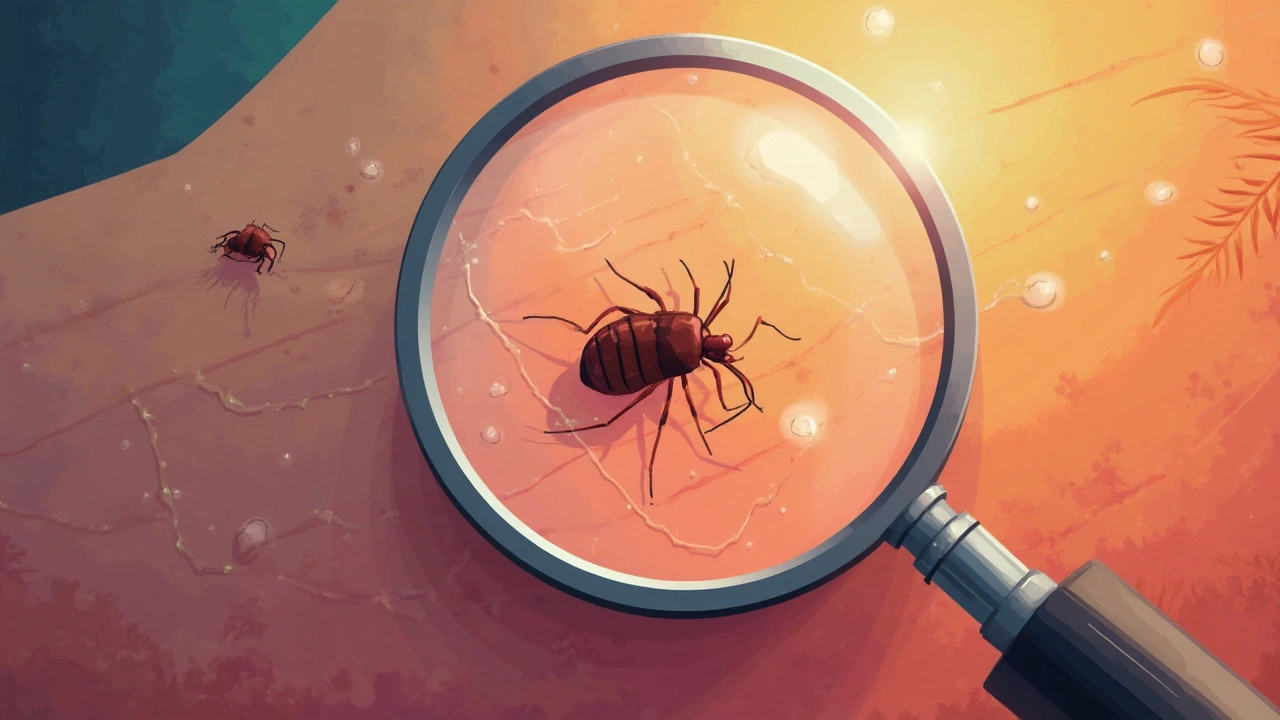Picture the itch that just won't let up. It starts as a tickle, becomes a distraction, and before you know it, you’re clawing at your wrists at 3 am. That’s scabies for you—sneaky mites burrowing into the skin, leaving misery in their wake. Acticin is the unsung hero people count on to wipe these tiny pests out. But is it really that simple? Let's unpack how Acticin cream becomes your new best friend when mites come knocking and what you should really know if you’re about to slather it on.
What is Acticin and How Does It Work?
First things first—Acticin isn’t magic, but it gets pretty close for anyone tangled up in the scabies web. Acticin is a brand name for permethrin cream, usually in a 5% formulation. It’s a topical medication, which is a fancy way of saying you rub it onto your skin where it gets to work. Permethrin’s main job? Paralyzing and killing the mites (Sarcoptes scabiei) and their eggs. Instead of just soothing the itch, it wipes out the root cause. Permethrin has actually been around for a while —since the late 1970s. It’s well-studied, and is now on the World Health Organization’s List of Essential Medicines. That’s the kind of resume you want on your side. Acticin’s active ingredient, permethrin, is a synthetic version of a natural chemical in chrysanthemum flowers, but don’t expect a floral aroma; the cream smells pretty neutral.
After application, permethrin acts fast—paralyzing mite nervous systems so they can’t function or reproduce. While they don’t instantly vanish, their hold on your skin loosens within hours. Most people see dramatic improvement in itching and inflammation within one to two weeks. The biggest mistake? Not treating every inch of skin as advised or skipping family members. Scabies isn’t polite; it spreads like wildfire, so if one person is itchy, everyone’s on deck. Acticin is prescription-only in South Africa, so you’ll get instructions straight from your doctor or pharmacy. Don’t even think about using only a dab. The cream must cover the entire body from the neck down, sometimes even including the scalp in babies. Miss a patch, and you’re inviting mites to stick around.
This is one heavy-duty cream, but it’s safe enough even for babies above two months (though babies and pregnant women should always check with their doctors first.) Most folks tolerate it just fine. Side effects? Some mild burning or stinging, sometimes a short-lived rash or redness. Only rarely do people react more strongly. Just remember: itching may stick around for a week or so. This doesn’t mean Acticin failed—it’s just your immune system reacting to leftover mite debris.
Recognizing Scabies and When to Use Acticin
You might wonder, "Is this even scabies?” Often, scabies is misdiagnosed as eczema or dermatitis. The giveaway? Intense itching that gets worse at night, thin red lines (burrows) between your fingers, on your wrists, elbows, waist, or even genitals. Kids might get scabies on their faces, palms, or soles too. In South Africa, scabies outbreaks aren’t unheard of—especially in schools or crowded homes. According to SA’s Department of Health, scabies is most common in places where people are in close contact—think dorms or old age homes.
If you suspect scabies, your first stop should always be a doctor, not Dr. Google. Why? Because some rashes or infections might get aggravated by self-treating with the wrong cream. A doctor will often scrape a burrow gently and check for mites or eggs under a microscope. If the diagnosis is clear, you’ll get a script for Acticin. The trick is to start treatment as soon as possible. Scabies won’t go away on its own, and scratching just means more skin damage and possible infections. It’s not just about comfort—it’s about stopping the spread. If someone in your household has confirmed scabies, everyone should use Acticin at the same time, even if they aren't itchy. The CDC in the US and local SA medical guidelines both stress group treatment to avoid endless reinfection.
Scabies can complicate things for folks with weakened immune systems, kids, and pregnant women. Always check with your doctor about dosing or if additional follow-up is recommended. If you have crusted (Norwegian) scabies—a rare but more severe version—you’ll likely need oral medication in addition to permethrin cream.

How to Apply Acticin: Step-by-Step
When it comes to applying Acticin, the details matter. People often skimp on application and then wonder why scabies keeps making a comeback. Think of this as a battle plan—you want to leave zero hiding spots for mites. Here’s a step-by-step breakdown:
- Wash Up Properly: Take a warm bath or shower and towel-dry your body thoroughly. Clean skin ensures better absorption.
- Start Low, Move Up: Squeeze out enough cream to cover your entire body neck-down. For kids, and if your doctor says so, apply to the scalp, ears, and face (avoiding eyes and mouth).
- Don’t Miss the Nooks: Pay attention to the spaces between fingers and toes, under the nails, genitals, armpits, back of knees, and belly button.
- Leave It On: Don’t wash it off for 8-14 hours. The usual routine is overnight. If you wash your hands during this time, reapply cream right away.
- Clean House: Fresh pajamas and bed linen are a must after the treatment. Wash everything in hot water (at least 50°C) and machine dry on high heat.
- Treat Contacts: Anyone who had skin-to-skin contact with you recently should use Acticin at the same time, even if they're symptom-free.
- Repeat If Needed: Sometimes doctors recommend repeating treatment seven days later, especially if symptoms linger.
Here’s a quick data snapshot on typical usage and results:
| Application Area | Age Group | Time Left On | Need for Repeat |
|---|---|---|---|
| Neck down (Body) | Adults/teens | 8-14 hours | Only if symptoms persist |
| Face, scalp, ears | Babies/kids (check with doctor) | 8-14 hours | Occasionally |
Don’t forget about things that can’t be washed easily—seals them in a plastic bag for at least three days. Mites can’t live off the body for more than 2-3 days.
Dealing with the Itch: Recovery and Aftercare Tips
Killing mites is step one, but what about the famous scabies itch? Weirdly enough, the itching can sometimes get even worse after treatment. This doesn’t mean the medicine failed—the dead mites and eggs leave digestive proteins and other debris behind, which your immune system keeps reacting to. Here’s the good news: the itching eases up for most folks in a week or two. But for some, it lingers a bit longer. Topical steroids or antihistamines (like cetirizine or loratadine) can help take the edge off. You don’t want to go overboard with steroids, but a short course can bring big relief.
One wild fact: about 10-15% of people treated for scabies still feel itchy for up to a month after wiping out the mites. If you still see new bumps after 3-4 weeks or things get worse, check in with your doctor—this could signal a different problem or a second infestation. Secondary bacterial infections are another biggie, especially if you scratch enough to break the skin. Watch out for yellow crusts, pus, or hot, painful skin—signs you might need antibiotics. Keep nails short, try cotton gloves at night, and moisturize dry or sensitive areas to avoid irritating your healing skin.
Keeping your bedding and clothes clean is huge. Launder sheets, towels, and worn clothes daily until everyone in the home is itch-free for a week. No access to a washing machine? Ironing clothes or exposing them to hot sunlight also speeds up killing off stray mites. Avoid tight clothes that trap sweat and increase irritation. If you’re caring for kids, teach them not to scratch (as much as that's possible), and encourage regular handwashing. Boost your recovery with habits that promote healthy skin—drink enough water, use gentle soaps, and skip harsh exfoliators for now. If the scratching or side effects get out of control, don’t tough it out—call your doctor for backup.

Prevention and Key Facts Worth Knowing About Acticin
Once you’re free from scabies, you’ll probably want to keep it that way. Some smart prevention tips make all the difference. First, avoid skin-to-skin contact with anyone who has untreated scabies, whether at home or (let’s be honest) even at the gym or hostel. Don’t share bedding, towels, or clothing. At school or work, notify staff or friends quietly if you’re treating for scabies—the goal isn’t to embarrass anyone, but to slow down the spread. In Durban and other busy spots, scabies outbreaks can crop up more easily during winter or in boarding facilities where people bunk close together.
Another fact worth knowing: Acticin/permethrin is considered safe in pregnancy (Category B in the US), but always check with your healthcare provider first. In extremely rare cases, people are allergic to permethrin or its base. For them, alternatives like sulfur ointment or ivermectin tablets are sometimes used, but those come with their own precautions. Here’s a neat one—pets don’t get human scabies, so don't stress about treating your cat or dog unless your vet specifically says so.
Don’t be tempted by over-the-counter remedies, herbal ointments, or home hacks. Scabies is tough, and only potent medications like Acticin do the job right. Studies out of Europe and the US found permethrin-based creams wipe out mites in over 90% of cases on the first go—with dramatic drop-offs in community outbreaks when everyone follows the treatment protocol. Keep your prescription in a safe spot, and never use leftover cream for "that rash next month"—scabies treatment is an all-in affair, not a quick fix.
So, next time an itch crops up that you just can’t shake, remember that Acticin is more than just a cream. It’s a roadmap to getting your skin, your sleep, and your sanity back on track. Use it right, and you close the chapter on scabies way faster than if you wing it. Nobody loves talking about mites, but with the right info and tools, you can get past scabies and move on with your life itch-free.


Badal Patel
July 18, 2025 AT 17:46Ah, Acticin cream! The miraculous elixir that promises salvation from the infernal torment we call scabies! One simply cannot underestimate how this potent topical treatment combats the relentless mites with such precision! But, pray, let us not forget that proper application is an art in itself—covering every inch, lest the pestilence return unscathed.
One MUST adhere strictly to the prescribed duration and layering of the cream; otherwise, all efforts are in vain!!! The relief, when it comes, is almost ethereal—but patience is the key. Rash and itching can persist for days; do NOT panic!!! Instead, prepare yourself with soothing measures. Truly, Acticin is a beacon of hope in the dermatologist's arsenal!
KIRAN nadarla
July 18, 2025 AT 20:20First off, let's clear up some misconceptions about Acticin (permethrin). The article's vague phrasing needs precision—Acticin is a synthetic pyrethroid, not just any 'scabies cream.' If you misuse it, not applying it to the whole body or neglecting repeat treatments, you might end up with persistent infestation.
Also, it's imperative to distinguish scabies from other skin conditions because indiscriminate use risks resistance and side effects. Grammar-wise, I hope people read the instructions properly because the difference between 'Apply once' and 'Repeat after 7 days' is huge! Don't be lazy with the details if you want real relief.
Kara Guilbert
July 19, 2025 AT 02:06Honestly, I feel like this guide doesn’t stress enough how important it is to also treat your environment when dealing with scabies. Acticin cream might kill the mites on your skin, but if you ignore your bedding and clothes, you’re just inviting the pests back.
People really need to be responsible and clean all affected areas. Not only out of self-care but respect for others you might come in contact with. Sharing is caring, but not when it comes to scabies, right? It's about the community health, and we should all be mindful about spreading or re-spreading infections.
Also important: if you’re pregnant or breastfeeding, check with your doctor before using Acticin. Not everything safe for some is safe for everyone.
Sonia Michelle
July 19, 2025 AT 17:23This post does well to educate, but I’d like to emphasize the mental toll scabies can have. The constant itching and discomfort often lead to stress and anxiety, which might exacerbate the symptoms. Using Acticin is a great step, but we must also remind folks to seek support and practice self-care during treatment.
Engage in relaxing activities, maintain good hygiene routines, and keep an open line with healthcare providers. Healing isn’t just a physical journey—it’s emotional too. So here’s to quicker relief and stronger spirits during the process!
Neil Collette
July 20, 2025 AT 11:26Wow, everyone’s so serious about Acticin like it’s some miracle cream—when in reality, it’s just another overhyped pharmaceutical product. Look, yes, it kills the mites, but let’s not pretend it’s a flawless magic wand. Some people itch like crazy even after treatment.
And don’t get me started on how they market this stuff like you’ll be cured overnight and can just toss your sheets in a corner. Nope. You gotta wash EVERYTHING, multiple times! I mean, come on, does anyone actually READ the instructions? Plus, allergic reactions? Not talked about enough.
Just saying, if you expect perfection, you’re gonna be disappointed.
James Lee
July 21, 2025 AT 15:13Acticin, huh? Yeah, I tried it once, and honestly, it worked fine but wasn’t as dramatic as some make it out to be. The itching relief took a few days to kick in; patience is key.
Totally agree that you have to cover everything properly, or else you’re just wasting product. Also, I found the scent a bit strong and the texture thick—sort of annoying to sleep in. But hey, better a little discomfort than scabies.
People should remember that these treatments aren’t glamorous. They’re medical necessities, plain and simple.
Dennis Scholing
July 22, 2025 AT 00:56Greetings everyone. From a clinical perspective, the use of Acticin cream (permethrin 5%) stands as the first-line treatment for uncomplicated scabies infestation in the vast majority of cases. It is imperative that patients adhere strictly to application instructions, covering the entire body surface from the neck down, including under nails and skin folds.
Follow-up after a week to assess efficacy is crucial, given that itching and rash may persist despite mite eradication. Should symptoms persist, consultation with a dermatologist is advised to explore alternative diagnoses or retreatment.
Moreover, we must emphasize patient education to prevent reinfestation, including laundering clothing and bedding at high temperatures.
Kasey Lauren
July 22, 2025 AT 19:00Hey, I just wanted to say that this cream really helped my friend who was struggling for weeks with intense itching. The guide here is pretty helpful for anyone feeling lost about what to do.
Take your time putting it on carefully, and don’t skip the repeat treatment. Also, don’t get discouraged if the itching sticks around a bit after—you’re on the right track! Just keep your spirits up, know it’s normal, and it’ll pass.
Big thumbs up for the relief it brings!
Abhimanyu Singh Rathore
July 25, 2025 AT 02:33Oye, let me tell you, the overuse of punctuation marks in this article is as trying as the itching itself! But jokes aside, the key here, as stated many times but not emphasized enough, is meticulous application. You must NOT miss even the tiniest bit of skin.
One might be tempted to rush through the process — major mistake!! Scrutinize the instructions and resist the urge to be lax.
Trust me, I made that mistake once and ended up suffering for longer than necessary. So be vigilant, people.
Stephen Lewis
August 1, 2025 AT 15:06Thank you to the author for sharing this essential guide. It is crucial from a healthcare perspective that patients receive clear, thorough instructions to maximize the efficacy of Acticin treatment for scabies.
As a formal reminder, anyone diagnosed with scabies should also inform close contacts and ensure environmental hygiene to prevent reinfestation. Patient adherence cannot be overstated in this context.
Furthermore, while Acticin is generally safe, potential allergic reactions should be reported immediately to a healthcare practitioner.
Lynn Kline
August 17, 2025 AT 17:13What a relief to see a guide that actually cares about the folks suffering from scabies! This uninvited itch can feel so isolating, and knowing there’s a clear path to relief really lifts a weight off our shoulders.
So important to be thorough and kind to yourself through the process. Remember to cleanse your bedding with love and patience. Also, if you have pets, make sure they’re checked out, as these little invaders can sometimes hop around.
Stay strong, friends! You’re not alone in this itchy battle.